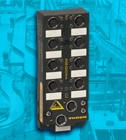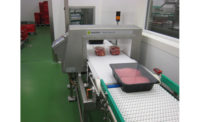
For years, standard proximity sensors have been used in applications requiring metal detection, ranging from packaging and material handling to agriculture and oil and gas. Engineered as an early solution to achieve consistent metal detection, standard proximity sensors were widely used in a variety of applications, from detecting aluminum cans on an assembly line to sensing a steel gate on a tank. Though a popular solution, these devices present challenges in applications that require reliable metal detection.
Sensing metal components can be difficult given the versatility of ferrous and non-ferrous metals and range of thicknesses. Obtaining reliable results for multiple metals with a single proximity sensor can be problematic given the limitations associated with this technology. For instance, these sensors are incapable of sensing all metals at the same distance, which results in mounting adjustments that may not be supported by an application’s operation specifications. These adjustments significantly impact productivity by requiring frequent machine halts. Additionally, standard proximity sensors lack flexibility and durability, often making them unsuitable for today’s demanding industrial requirements.
With the development of Factor 1 sensing technology featuring increased reliability, enhanced versatility and improved durability, these solutions can accommodate modern industrial environments. This technology enables a single Factor 1 sensor to accurately detect aluminum, stainless steel, mild steel, copper, lead, brass and other metals at the same rated distance-without altering the position of the device. Further, their inherent durability limits the replacement costs and inventory overhead associated with standard proximity sensors. With versatile housing options and mounting capabilities, Factor 1 sensors, from Turck Inc., Minneapolis, can accommodate a wide range of applications and environmental conditions.
Performance limitations associated with standard proximity sensors
Traditional inductive proximity sensors are designed for wear-free, non-contact detection. Featuring a coil and ferrite core arrangement, they generate a high-frequency electromagnetic field. When a target passes through the magnetic field, currents induced on the surface of a target result in the loss of energy in the oscillator and generate a signal to turn the solid-state output on or off. Once a metal object exits the sensing field, the oscillator regenerates and the sensor returns to its normal state.
Sensing range
The operating range of standard proximity sensors varies based on the type of metal being detected. The sensing range essentially is a function of the diameter of the sensing coil and the rated operating distance, which is used to designate the nominal operating distance. However, this rated operating distance does not factor in manufacturing tolerances or variations due to external conditions, such as voltage or temperature, which can affect the sensors ability to deliver consistent performance.
Proximity sensors react differently to ferrous and nonferrous metals, which impacts the operating distance of the sensor. To achieve optimal performance in applications that require sensing non-ferrous metals, the sensing range must be adjusted to accommodate a correction factor. These correction factors are nominal values, with deviations due to variations in oscillator frequency, alloy composition, purity and target geometry.
The standard operating range of a proximity sensor is based on its response to a one-millimeter thick square piece of mild steel, which is between 7-8 millimeters from the target. When sensing a different metal component, the sensor must be adjusted. The more conductive the metal is, the closer the sensor must be mounted to the object to achieve reliable results. For example, when sensing aluminum, the operating range is reduced by 20-30%-making it approximately 2 millimeters shorter that the standard range.
Mounting
Standard proximity sensors allow both embeddable and non-embeddable mounting, which allows versatility and creates additional considerations, such as reduced sensing range, magnetic interference and mechanical vulnerability.
When the sensor is designed for embeddable mounting, it includes a metal band (shield) that surrounds the sensor, minimizing magnetic interference. The oscillator creates a high-frequency field radiating from the coil in front of the sensor, centered around the axis of the coil and the ferrite core bundles, and directs the electro-magnetic field to the front of the sensor. Embeddable sensors can be flush-mounted in metal to provide a degree of protection from incidental contact and mechanical damage. Though embedded mounting offers some safeguarding, it also results in a reduced sensing range.
Non-embeddable sensors do not have the metal band, and therefore must be mounted in a metal-free zone. Metal parts near a non-embeddable sensor can influence the electromagnetic field and impact sensor operation, causing false results. Though non-embedded mounting provides a longer sensing range, the sensors protrude from the mounting surface, making them more susceptible to physical damage from the target hitting the sensor as it passes or from accidental human contact.
Other influences make both embeddable and non-embeddable sensors mechanically vulnerable, including temperature and voltage variations, and industrial factors such as exposure to high levels of noise or weld fields. Additionally, mounting standard proximity sensors can also be challenging in applications with limited spacing. If the application requires multiple sensors to be mounted in close proximity, it can cause coupling between the oscillator coils, which then causes the sensors to trigger each other. Sensor manufacturers have different requirements for the mounting space between their sensors, but using sensors with different frequencies can lessen the space.
Cost considerations
Standard proximity sensors are not constructed to withstand extreme variations in temperature, heavy vibration or washdown conditions. This requires manufacturers to keep a large supply of sensors on hand to replace damaged equipment. Additionally, given that these sensors are prone to breakage, this causes frequent production halts, impacting profitability through lost productivity.
The need for sensor advancement
Factor 1 sensors use multiple coils that enable them to detect all metals at the same range without requiring adjustment. Instead of a single coil inducing and being affected by eddy currents on a target, Factor 1 sensors use separate, independent sender and receiver coils. This design affords Factor 1 technology multiple benefits over standard proximity sensors, including metal detection reliability, mounting versatility, enhanced durability and improved productivity and profitability.
By detecting both ferrous and non-ferrous components at the same operating range, these sensors provide an overall longer operating range.
Further, since these sensors are inherently immune to magnetic field interaction, they are ideal for applications where alternative technologies would fail due to interference with magnetic fields, such as welding, lifts and electronic furnaces.
Mounting versatility
Due to their design and construction, Factor 1 sensors can be mounted further away from the target, protecting them from damage. The absence of a ferrite coil also enhances mounting versatility by accommodating small spaces and metal-free mounting zones. Further, with embeddable designs and recessed mounting for non-embeddable options, Factor 1 sensors suit diverse application requirements.
With these mounting capabilities, Factor 1 technology avoids mechanical damage due to physical contact by a target or user. Recessed mounting protects sensors from industrial conditions that make both embeddable and non-embeddable sensors mechanically vulnerable, including temperature and voltage variations, and environmental factors like exposure to washdown, high levels of noise or weld fields.
Their ability to sense any type of metal at the same operating range accommodates applications with limited space mounting. By not requiring personnel to manually manipulate the sensor’s position, a single Factor 1 sensor can be mounted in small or difficult-to-access areas where both ferrous and non-ferrous metals must be detected. This is also beneficial in situations where implementing a larger sensor is not feasible.
Durability and flexibility
Factor 1 sensors are designed for durability and performance flexibility. With a variety of housing options available, improved cap designs and resistance to harsh industrial environments, Factor 1 technology can withstand a variety of demanding applications.
To accommodate specific application requirements, Factor 1 sensors can be constructed with in a variety of housing materials, including plastic and metallic options. Further, instead of the sensor diameter being dictated by the size of the ferrite core/coil arrangement like with standard proximity, the Factor 1 sensor’s PCB can be designed for virtually any size and style housing, including ring-shaped, rectangular and barrel.
Along with diverse housing options, Factor 1 sensors are also engineered using more durable caps, with some manufacturers using plastic caps and others incorporating o-rings. Manufactures have also potted these sensors with different materials and modified the connector inserts for enhanced durability. These improvements not only prevent moisture and particle contamination from damaging the sensor, but also enable the device to withstand harsh conditions. Combining their expansive housing capabilities allow these sensors to accommodate industry applications with stringent sanitation regulations, such as pharmaceutical or food and beverage, enabling sensors to resist high pressure, aggressive cleaning agents and sudden temperature variations common in washdown conditions.
Another example of Factor 1 technology’s versatility includes small part detection. By utilizing a rectangular style housing for small part detection on the outside of the tube instead of using a standard ring style proximity sensor, a single Factor 1 sensor can replace multiple different sensor types, resulting in reduced inventories and less maintenance.
Productivity and profitability
With the performance advantages inherent in Factor 1 sensors, manufacturers can increase both productivity and profitability. Their sensing capabilities allow one sensor to accurately detect all metals at the same range, providing continuous production, without requiring unnecessary halts to adjust sensors detecting multiple types of ferrous and non-ferrous metals.
Since Factor 1 technology is engineered to enhance durability and its mounting flexibility improves sensor protection, it presents cost-saving benefits, as less sensors will fail due to mechanical damage associated with exposure to elements or incidental contact during production. Through this technology, manufacturers can minimize their sensor replacement costs.
Further, the elimination of manual manipulation and equipment replacements also increases cost-efficiency from a labor perspective. By minimizing maintenance required for continual performance, manufacturers will reduce cost needed to sustain sensors operation. Additionally, with less production downtime, users can increase overall profitability by minimizing lost revenue due to process interruption.
Conclusion
With an advanced design, which lacks a ferrite core, Factor 1 technology provides flexibility in both mounting and performance capabilities. Delivering extended range, recessed mounting capabilities, unique housing styles and washdown suitable properties, Factor 1 sensors offer a viable replacement option for standard proximity sensors to better meet today’s diverse and demanding application requirements. Factor 1 technology minimizes production downtime and reduces maintenance requirements to promote overall process efficiency, productivity and profitability.

